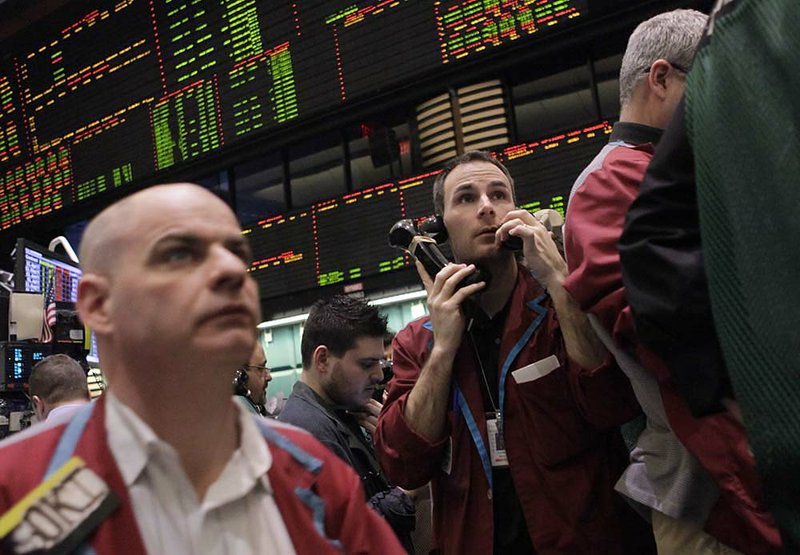LITTLE ROCK — Oil surged to $100 a barrel in New York for the first time since 2008 on Wednesday as Libya’s violent uprising threatened to disrupt exports and spread to other Middle East oil producers, analysts said.
Similar uprisings in Tunisia and Egypt earlier this month had markets on edge before protests escalated in Libya, which has the biggest oil reserves in Africa.
“We’re crossing $100 because with the cut in Libyan output, the unrest in the Middle East is actually having an impact on oil supply,” said Phil Flynn, vice president of research at PFGBest in Chicago. “There’s concern that unrest will spread further, threatening Saudi Arabia and other producers.”
West Texas Intermediate crude for April delivery jumped $2.68, or 2.8 percent, to settle at $98.10 per barrel on the New York Mercantile Exchange. Earlier in the day, prices hit triple digits for the first time since Oct. 2, 2008. West Texas Intermediate crude has risen 18 percent since Feb. 14.
In London, Brent crude rose $5.47, or 5 percent, to $111.25 per barrel on the ICE Futures exchange.
French oil giant Total said it started to wind down its oil production in Libya. The company produced an average of 55,000 barrels per day last year. That follows similar moves by other oil companies working in the country.
Libya’s biggest oil producer, Eni, idled operations that produce 244,000 barrels of oil and gas per day. Spain’s Repsol-YPF and Austrian oil company OMV also suspended operations.
Barclays Capital estimates that as much as 1 million barrels per day of production has been shut down so far. In January, Libya produced almost 1.7 million barrels per day of oil and natural-gas liquids, according to the International Energy Agency. Libya is the ninth-largest producer among the 12 members of the Organization of Petroleum Exporting Countries.
A tanker loaded 600,000 barrels of crude at two Libyan ports and set sail Wednesday, suggesting some of the nation’s supply is still flowing.
The ship Seabravery picked up the oil at the ports of Zawia and Es Sider and sailed before dawn, according to Dimitris Tsahalis, chartering manager at Thenamaris Ships Management Inc., which owns the vessel. The company is based in Athens, Greece.
Production losses will be felt mostly in Europe. Ireland relies on Libya for 23 percent of its oil imports, and 22 percent of Italy’s oil imports are from Libya. The U.S. imported only about 51,000 barrels per day from Libya, less than 1 percent of its total crude imports.
The International Energy Agency and Saudi Arabia have pledged to make additional oil available to cover any shortfall in world supplies, but that hasn’t eased tensions in oil markets.
Larry Goldstein, a director at the Energy Policy Research Foundation in Washington, said Libya’s oil is a high-quality variety. Some refineries won’t be able to process Saudi Arabia’s lower-grade crude, so a sustained shutdown in Libya could start a bidding war for comparable kinds of crude.
“That would raise product prices immediately,” Goldstein said.
Analysts say concerns about violence in North Africa and the Middle East have added a “fear premium” of about $10 per barrel of oil.
The rise has pushed retail gasoline prices higher in the U.S. despite ample supplies in most parts of the country.
Gasoline prices jumped 8.2 cents per gallon in the past month and $1.28 per gallon in the past year. The national average for a gallon of regular on Wednesday rose another 2.3 cents to $3.194, according to AAA, Wright Express and Oil Price Information Service.
In Arkansas, the average price of a gallon of gasoline Wednesday rose 3.4 cents to $3.071, according to AAA.
Tom Kloza, publisher and chief oil analyst at Oil Price Information Service, said he expects gasoline prices will continue to rise in the next few months to a spring peak of between $3.25 and $3.75 per gallon. And energy analyst Jim Ritterbusch said he doubts the national average will climb to $4 a gallon or higher, but he said prices are difficult to predict because of the rapidly changing situation in North Africa and the Middle East.
U.S. Treasury Secretary Timothy Geithner said Wednesday that the economic recovery has put the world on a better footing to withstand the increase in oil prices caused by international turmoil.
“The economy is in a much stronger position to handle” rising oil prices, Geithner said during a Bloomberg Breakfast in Washington, D.C. “Central banks have a lot of experience in managing these things.”
Analysts estimate that over a year, $100 oil would reduce U.S. economic growth by 0.2 or 0.3 of a percentage point. So rather than grow an estimated 3.7 percent this year, the economy would expand 3.4 percent or 3.5 percent. That would likely mean less hiring and higher unemployment.
Information for this article was contributed by Chris Kahn, Sandy Shore, Jonathan Fahey, Jeannine Aversa and Christopher S. Rugaber of The Associated Press, and Alaric Nightingale, Rich Miller, Margot Habiby and Mark Shenk of Bloomberg News.
Front Section, Pages 1 on 02/24/2011

